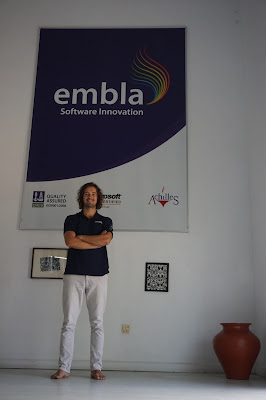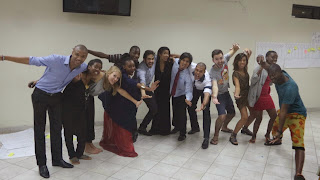The biggest motivation for doing an internship
in Japan was my interest in this country, and I wanted to improve my Japanese a
bit as well.
 |
| Airport welcome |
My first meeting with AIESEC in Sendai was
when I arrived at the airport. They offered me a warm welcome, and had even
made a big sign with my name on, which they must have put a lot of time and
effort into.
AIESEC also helped me in the beginning with a
lot of practical things in order for me to get adjusted to the Japanese life.
As a foreigner in Japan it takes some time to get used to everything,
especially since not many people here talks English. Even a trip to the grocery
store was a challenge, since I didn’t have a clue what most of the items were
and everything was written in Japanese. But thanks to the AIESEC members, this
process went a lot smoother. At my second day in Japan they showed me around my
neighborhood, introduced me to the most useful stores, and went to the
electronic store to get Wi-Fi
The
company
 |
| At work, holding a presentation |
The company I worked for is called Hyakusen
Renma, and in Japanese it means something like “one who has fought a hundred
battles”, which is, even in Japan, a strange name for a company.
But after all, Hyakusen Renma is not your
typical Japanese company. Unlike most firms here, the employees don’t have to
wear a suit to work, there was not much hierarchy at the office, and instead of
going to an izakaya (Japanese bar/restaurant) after work on Fridays, we often
stayed at the office playing board games. I think they must have had at least
over 50 different games in their office, and I think I played at least one new
game each week!
 |
| At work, holding presentation about a new service |
Hyakusen Renma is a small IT firm, with
offices in both Tokyo and Sendai. I worked in Sendai where there were about 15
employees, all of them Japanese.
The company is mainly developing various
internet services where a majority is focused on the travelling sector. So
naturally, my work tasks were to come up with ideas for new services, and also
help improving their existing services. This was very challenging since I
didn’t have a lot of experience within innovation and entrepreneurship, but I
was fortunate enough to work together with a talented Japanese intern.
 |
| Teaching co-workers English |
Later I also held weekly English classes for
the co-workers, since they wanted to improve their English. I had never taught
a language before and English is not my native language as well, so it was a
little tricky. But I got used to it after some lessons and we had a great time
together in the classes.
It is important to mention that among the
office, there was only my boss and the other intern who could speak English
fluently. And so communicating with the others was a little hard at the
beginning because my Japanese was very basic. Eventually it went a lot smoother
as my Japanese slowly improved, and we could meet somewhat “halfway”
communicating partially in both English and Japanese.
I think I was quite lucky with this company,
since they are not as conservative as the standard Japanese company. To my
pleasant surprise, there was not a huge extent of hierarchy in the office. We
had one big open landscape office, where we all could see each others and I sat
right next to the boss. The office environment was very casual and we could
easily talk to each other without any formalities. We were also free to take
frequent short breaks so we could go outside and get some fresh air. So in
other words it was a very nice workplace with a lot of nice co-workers.
Japanese
work culture
The company’s office hours were from 9:00 to
18:00, but it seemed like almost everyday, the employees worked overtime.
Luckily, I didn’t need to stay any longer and I usually went home the same time
as my boss. Apparently in Japan you should not leave the office before the boss
goes home, but that didn’t apply to me since I was just an intern.
 |
| Company lunch |
I was a bit surprised over the rigid rules as
well. I had lunch break from 12 to 1, and I thought the time was flexible. And
so one day I decided to take my break half an hour earlier to get ahead of the
rush hour at the ramen shop, but then later my boss told me I couldn’t do that
again. The reason was simply that it was stated in my contract my break was
from 12 to 1, and I simply just had to follow that.
One of the most memorably moments from the
internship was when my boss took me and the other intern to a business
conference. This was the first time I had to use my suit for work and really
got to see the formal Japanese work culture. During the conference I got the
opportunity to mingle with the other Japanese businessmen, and exchange
business cards as well. Exchanging business cards is very typical in the
Japanese culture, and the whole process of exchanging cards is a lot more
complicated than I think it should be. Luckily, before to the event the
Japanese intern learned me the proper way to do it and we practiced a lot as
well.
Social
life and after work activities
During my stay I had a lot of pleasant social
events with AIESEC, among them were a welcome and farewell party, some
festivals and other cultural activities. They even organized a day trip where
we went to an onsen (hot spring), and to a well-known Japanese whiskey
distillery. It was very nice for me they could take me around and show me some
aspects of the Japanese culture I probably wouldn't have experienced on my own.
 |
| Trip to an onsen |
I also got well known with my boss as well,
and we had a day trip to Matsushima, which is known for the beautiful nature
and the birthplace of a famous haiku poem. We also went together to a baseball
match to watch the city’s local team play against one of the better teams in
the league. Although our team lost, I had a great time. Going to a sport event
in Japan was quite different compared to Norway. At football matches in Norway
the mood at the stadium becomes significantly worse when the home team is
losing, but for the Japanese they didn’t seem to get so affected by that fact.
But what I found most odd was the fact they were playing the opposing team’s
song in the stadium. It would be the same if they played “You’ll never walk
alone” at Old Trafford! And this I think is a good example that sometimes
Japanese are just too polite.
Traveling
and Culture
 |
| Tokyo by night |
During my stay I took the time to do some
travelling on my own. I visited both Tokyo and Fukuoka where I visited some
friends. Travelling in Japan can be a bit expensive, but at least there is
nothing bad to say about the transportation system, as it is incredibly
punctual and efficient. Trains are the most convenient way of getting around,
and they are always on time. Sendai was located a bit far away from Tokyo, but
with the high-speed train one way only took about 90 minutes.
What I maybe like most about Japan is its
food. It’s so delicious, and so much to choose from. The prices for eating out
is very cheap compared to Norway, for about 50 kr you can get a lot of food.
Most people tend to think of Japanese food as
mainly sushi, but there is so much more! Japan have a big food culture and the
Japanese cuisine consist of a variety of dishes from raw fish to deep fried
meat. My favorite food is Sukiyaki, which is a kind of hot pot with different
meat and vegetables in. Perfect to share with friends and colleagues after a
long day at the office.
At the
end
The time here went way too fast and before I
knew it, my two month internship was approaching an end. On the last day at
work I had a final presentation, summarizing my internship and my experiences
in Japan. I even managed to make half of it in Japanese, as I had already made
a promise to my boss. Therefore I very nervous having done all my previous
presentations in English, but somehow I pulled it off.
To finish my internship we all went to an izakaya after work to drink and celebrate a successful internship.
To finish my internship we all went to an izakaya after work to drink and celebrate a successful internship.
The AIESEC members were kind enough to see me
off at the train station before I took the train to Tokyo. It was very sad to
leave Sendai, but I will definitely come back one day.
Even though my internship was just for two months, I feel I got to learn and experience a lot. I’m not regretting my choice about going to Japan at all, and I will never forget the fantastic people I got to know there. I can warmly recommend going to Japan on an internship.
Even though my internship was just for two months, I feel I got to learn and experience a lot. I’m not regretting my choice about going to Japan at all, and I will never forget the fantastic people I got to know there. I can warmly recommend going to Japan on an internship.

































